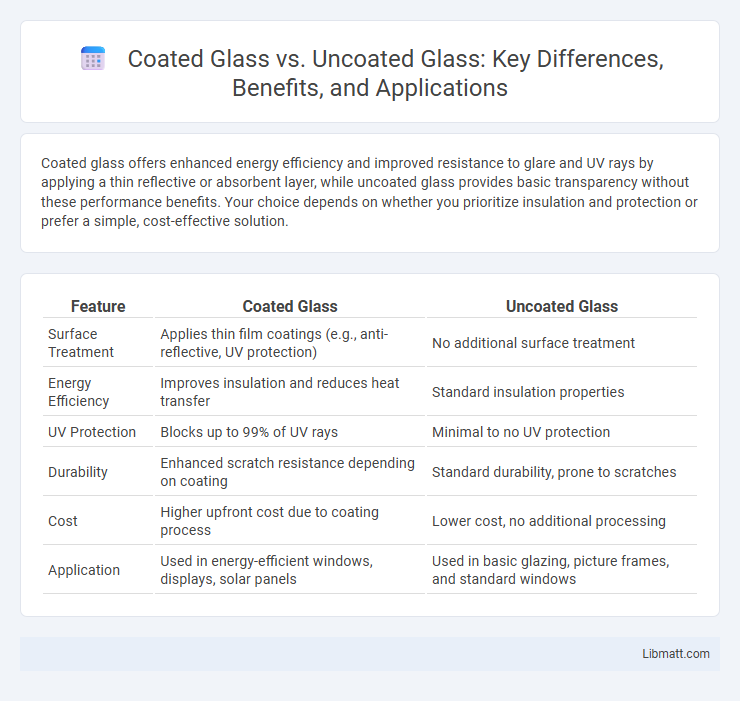Coated glass offers enhanced energy efficiency and improved resistance to glare and UV rays by applying a thin reflective or absorbent layer, while uncoated glass provides basic transparency without these performance benefits. Your choice depends on whether you prioritize insulation and protection or prefer a simple, cost-effective solution.
Table of Comparison
| Feature | Coated Glass | Uncoated Glass |
|---|---|---|
| Surface Treatment | Applies thin film coatings (e.g., anti-reflective, UV protection) | No additional surface treatment |
| Energy Efficiency | Improves insulation and reduces heat transfer | Standard insulation properties |
| UV Protection | Blocks up to 99% of UV rays | Minimal to no UV protection |
| Durability | Enhanced scratch resistance depending on coating | Standard durability, prone to scratches |
| Cost | Higher upfront cost due to coating process | Lower cost, no additional processing |
| Application | Used in energy-efficient windows, displays, solar panels | Used in basic glazing, picture frames, and standard windows |
Introduction to Coated and Uncoated Glass
Coated glass features a thin, transparent layer designed to enhance properties such as solar control, thermal insulation, and UV protection, making it more energy-efficient than uncoated glass. Uncoated glass lacks these specialized surface treatments, resulting in standard optical clarity but lower performance in heat regulation and durability. The choice between coated and uncoated glass depends on the application's requirements for energy savings, comfort, and environmental impact.
Definition and Types of Coated Glass
Coated glass refers to glass that has been treated with a thin layer of material to enhance its properties, such as energy efficiency, UV protection, or glare reduction. Common types include Low-E coatings, which improve thermal insulation by reflecting infrared energy, and reflective coatings, designed to reduce solar heat gain and increase privacy. Uncoated glass lacks these specialized layers, resulting in lower performance for insulation and sun control compared to coated alternatives.
Key Characteristics of Uncoated Glass
Uncoated glass typically features high light transmission and natural clarity, making it ideal for applications requiring minimal optical distortion. It lacks any surface treatments, resulting in greater susceptibility to scratches, smudges, and glare. This type of glass is commonly used in standard windows, picture frames, and protective coverings where durability is less critical.
Optical Performance Comparison
Coated glass significantly enhances optical performance by reducing glare and improving light transmission through anti-reflective properties, resulting in clearer and brighter visuals compared to uncoated glass. Uncoated glass often suffers from higher reflectance and light scattering, which can degrade visibility and image clarity. Advanced coatings can also provide UV protection and minimize smudges, further optimizing visual quality and durability.
Energy Efficiency: Coated vs Uncoated Glass
Coated glass significantly improves energy efficiency by reflecting infrared light and reducing heat transfer, which helps maintain indoor temperatures and lowers cooling and heating costs. In contrast, uncoated glass permits more heat flow, leading to increased energy consumption for climate control. Solar control coatings like Low-E (low-emissivity) glass enhance insulation performance, making coated glass a superior choice for sustainable building design.
Durability and Maintenance Considerations
Coated glass offers enhanced durability by providing resistance to scratches, UV rays, and chemical damage, significantly reducing the need for frequent maintenance compared to uncoated glass. Uncoated glass is more susceptible to surface wear and stains, requiring regular cleaning and careful handling to maintain clarity. Choosing coated glass can improve your product's longevity and reduce ongoing maintenance efforts.
Cost Implications
Coated glass typically involves higher upfront costs due to advanced manufacturing processes and specialized materials that enhance performance features like UV protection and energy efficiency. Uncoated glass is generally more affordable but may lead to increased energy expenses and faster wear over time, impacting your long-term maintenance budget. Evaluating the initial investment against potential savings in energy and durability helps determine the cost-effectiveness of each option for your project.
Applications and Industry Uses
Coated glass is extensively used in architectural applications, solar panels, and automotive windshields due to its enhanced properties like UV protection, energy efficiency, and glare reduction. Uncoated glass, while more cost-effective, remains prevalent in packaging, basic window panes, and picture framing where specialized surface treatments are unnecessary. The coating technology in coated glass enables advanced functionalities critical for green building certifications and high-performance automotive glazing.
Environmental Impact and Sustainability
Coated glass reduces energy consumption by enhancing thermal insulation, leading to lower greenhouse gas emissions compared to uncoated glass. The manufacturing process of coated glass often involves additional materials and energy, but its long-term environmental benefits offset initial impacts by improving building energy efficiency. Uncoated glass lacks these energy-saving properties, resulting in higher heating and cooling demands and increased carbon footprint over its lifecycle.
Choosing the Right Glass for Your Needs
Coated glass offers enhanced energy efficiency, UV protection, and glare reduction, making it ideal for environments requiring temperature control and increased comfort. Uncoated glass provides natural clarity and cost-effectiveness but lacks the additional functional benefits of coatings. Choosing the right glass for your needs depends on factors like climate, building orientation, and budget, ensuring optimal performance and value.
coated glass vs uncoated glass Infographic

 libmatt.com
libmatt.com